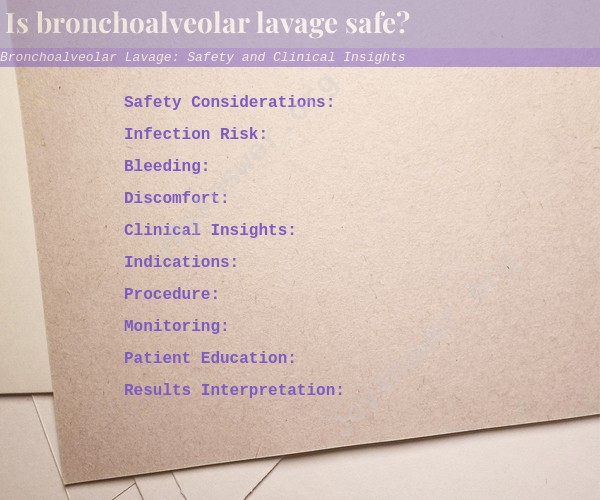Is bronchoalveolar lavage safe?
Bronchoalveolar lavage (BAL) is a medical procedure that involves washing the bronchial and alveolar areas of the lungs with sterile fluid. It is typically performed for diagnostic purposes to collect samples of cells and other materials from the lungs, which can be analyzed to diagnose various respiratory conditions or infections. While BAL is generally considered a safe procedure when performed by trained healthcare professionals, there are some important safety considerations and clinical insights to keep in mind:
Safety Considerations:
Infection Risk: One potential risk associated with BAL is the introduction of infection into the respiratory tract. To minimize this risk, the procedure should be performed using strict sterile techniques, and the equipment and fluids used should be free from contaminants.
Bleeding: There is a small risk of bleeding during or after the procedure, especially in individuals with bleeding disorders or those taking blood-thinning medications. Healthcare providers should be aware of these factors and take appropriate precautions.
Discomfort: BAL can cause discomfort or irritation in the airways, leading to coughing and shortness of breath during and after the procedure. Patients should be informed about these potential sensations.
Clinical Insights:
Indications: BAL is typically performed when other diagnostic methods, such as imaging or sputum samples, do not provide a clear diagnosis. It is often used to investigate conditions like pneumonia, interstitial lung disease, lung infections, or to rule out certain lung diseases.
Procedure: During a BAL procedure, a flexible bronchoscope is inserted into the patient's airways through the mouth or nose. Sterile saline solution is then instilled into the lungs and immediately aspirated along with the cellular and fluid content from the lung's airspaces. The collected sample is sent to the laboratory for analysis.
Monitoring: Patients undergoing BAL should be closely monitored during and after the procedure for any adverse reactions or changes in vital signs, such as oxygen saturation, heart rate, and blood pressure.
Patient Education: Patients should receive clear instructions on what to expect during and after the procedure, including potential side effects like coughing, sore throat, and chest discomfort.
Results Interpretation: The results of BAL analysis should be interpreted by a qualified healthcare provider, often a pulmonologist or pathologist, who can provide a diagnosis and recommend appropriate treatment based on the findings.
In summary, bronchoalveolar lavage is considered a safe and valuable diagnostic tool when performed by experienced medical professionals using proper techniques and precautions. Patients should discuss the procedure, potential risks, and benefits with their healthcare providers to make informed decisions regarding their lung health.













